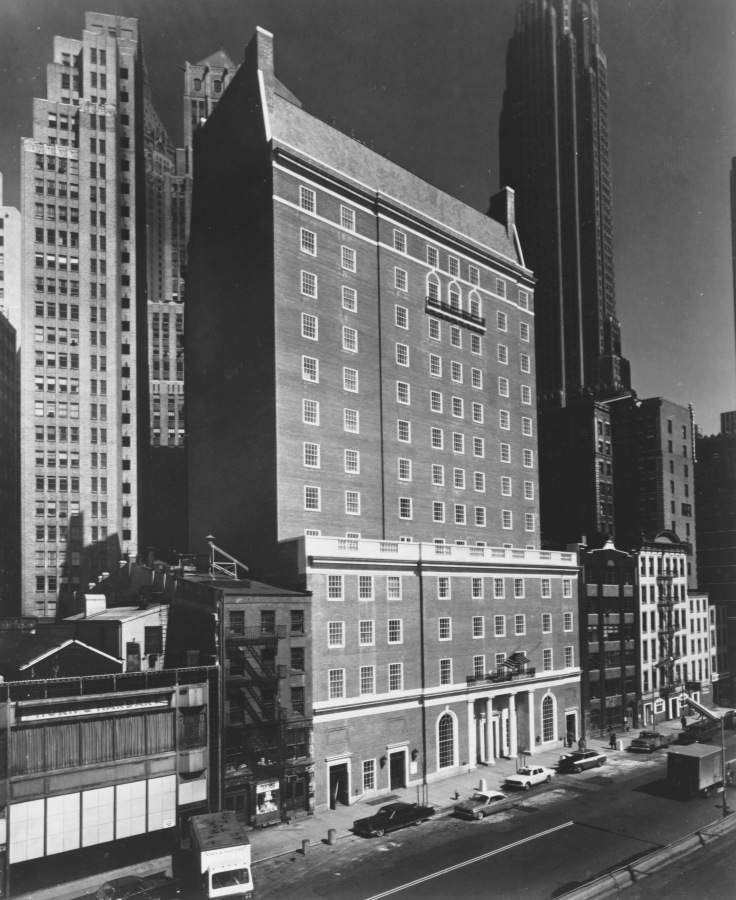Modern glass towers were rising across the city when one bank decided to embrace the Colonial and construct two faux-Georgian branches in 1960s Manhattan.
On May 18, 1964 the Franklin National Bank, founded on Long Island in 1926, opened two new branches in Manhattan. Both buildings, the Hanover Square branch at 132 Pearl Street and the Midtown branch at 410 Madison Avenue, were designed as odes to the Colonial by architects Eggers & Higgins.

The decision behind creating history-inspired buildings at a time when many companies were putting a modern stamp on their New York offices is detailed in a 1964 press kit I recently found at an estate sale.

The press kit materials, held in a blue folder stamped with the bank logo and the slogan “A Country Bank in New York,” include photos and info sheets on such topics as the bank history, architecture, interior furnishings and training of staff.

In the packet the buildings are described as “two unusually faithful examples of Colonial-Georgian architecture” completed “amidst the tower glass and steel structures of modern Manhattan.”

The intent was a bit of subliminal messaging – conveying “warmth and personal feeling” to convey reliability and tradition to their customers. The style was one that had already been used in branches in Nassau and Suffolk County.
Colonial craftsmanship and history was also a passion of Franklin Bank board chairman Arthur T. Roth, according to the press kit. “It would have actually cost us more money to put up a glass and steel skyscraper, but then we would have looked like everybody else,” Roth is quoted as saying. “This way, people will know we’re different the minute they see our buildings.
Both buildings were described as having facades of “Hermitage Colonial red shale brick set in a flemish bond with marble columns, window trim and cornices and cast stone balustrades.”

The “old time hand techniques” used in the construction of both buildings included plaster cornices, grapevine mortar joints, terrazzo floors and hand-set arches. Colonial Williamsburg was mentioned repeatedly as a source of inspiration, from the furnishings to the brickwork.

The historic theme was continued in the design and furnishing of both branch interiors. Colonial Williamsburg was again an inspiration, in some instances quite literally. In the Hanover Square branch the massive chandeliers and furniture were replicas of those at Williamsburg. Although in the case of the furniture the press kit lauded the use of modern technology such as “scotch-guarding.”

The design of the interiors was a collaboration between the architects and Helen O’Connell, their decorating consultant. Ms. O’Connell was able to delve into Mr. Roth’s own Early American collection for the decorating.
Interestingly the design swerved to a “Gay Nineties mood” in the staff cafeteria and lounge. Unfortunately no photos of those spaces were included in the press kit.

Staff members enjoying those spaces would have gone through an intensive training program. Around 200 new staff members were hired for the city banks, and over half of them were women. While the total training program ran for six weeks and included lectures on history, telephone manners and customer care, the press kit particularly lauded the special sessions on teaching “career girls” how to work in “smarter executive offices.”

The new staff were given four hours with Vera Holden, a former model and owner of the Suburban School of Grooming in Sommerville, N.J. Holden taught the hires about clothing, makeup and good posture. “Don’t slump . . . heads up, shoulder relaxed, hands barely touching hips,” she advised “Pinch your shoulder blades together, stand tall, tummy in, and start walking.” Her advice if you were “two pounds over your best weight” was “diet at once!”
The men were not ignored the press release assured. They were advised on getting rid of “extreme” styles and sticking to conservative colors and neatly trimmed hair.

The opening of both branches was celebrated with a series of Colonial-style receptions held from May 12 through 15, 1964. The menu included recipes inspired by 18th century cookbooks and waiters were attired in “costumes of the period with white stockings and wigs” for the event.

Franklin built other Georgian-inspired banks in the city but the use of Early Americana to convey stability was not to last; the company collapsed in the 1970s. The 12-story Hanover Square branch was demolished in the 1980s. The smaller seven-story Midtown Branch at the northwest corner of East 48th Street and Madison Avenue has managed to survive. A Chase branch is currently located in the building, but is scheduled to close on June 21, 2019.




Contemporary photos by Susan De Vries, May 2019.
All images from the collection of Susan De Vries.







So interesting, Susan! You always manage to find the human stories in a building’s history.
LikeLiked by 1 person